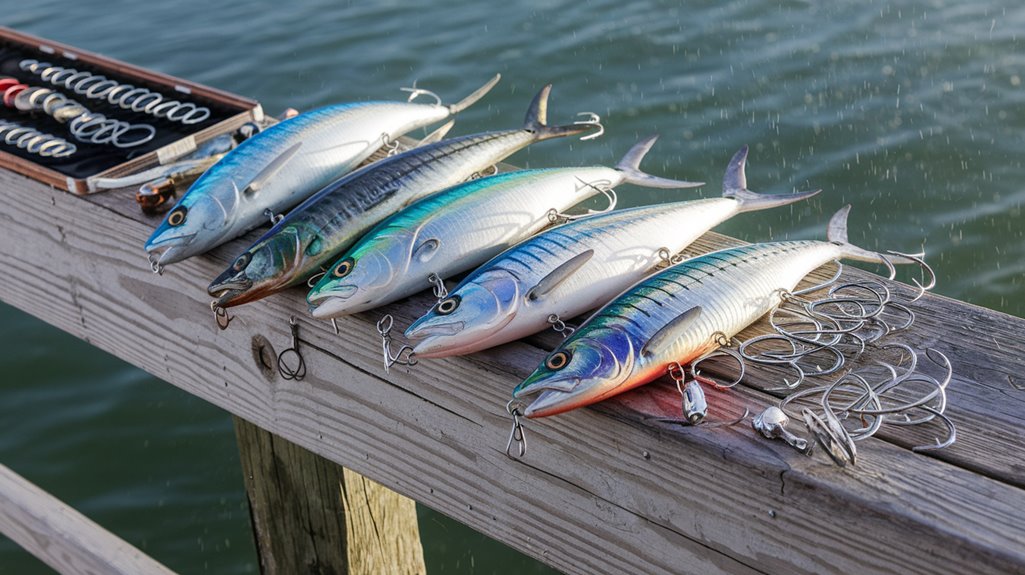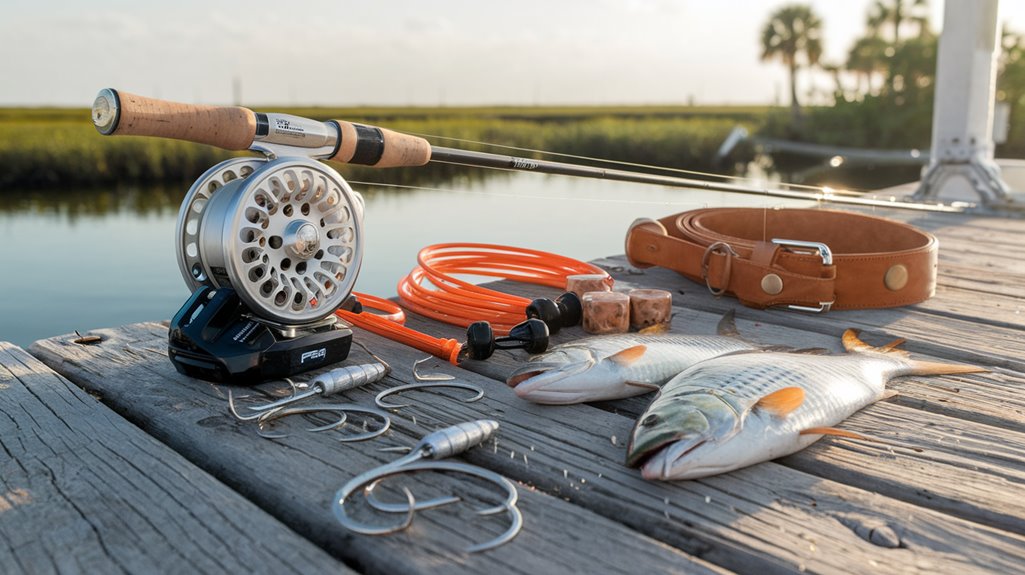Whether you're chasing silver kings in Charleston Harbor or stalking them along the barrier islands, you'll need the right gear to succeed at tarpon fishing in South Carolina. The combination of powerful fish, challenging conditions, and specialized techniques demands a carefully selected arsenal of equipment. From your rod-and-reel setup to your terminal tackle choices, each piece of gear plays an essential role in landing these magnificent gamefish. Let's explore the important components that'll transform your tarpon adventure from frustrating to fantastic.
Key Takeaways
- Medium-heavy to heavy action 7-8 foot rod paired with 6000-8000 series spinning reel for optimal control during fights.
- 30-80 pound braided mainline with 50-pound fluorocarbon leader to handle powerful runs and reduce line visibility.
- Quality 6/0 or larger circle hooks with reliable 80-pound rated swivels for secure hook-ups and successful releases.
- Functional livewell system with proper aeration to keep bait healthy, along with surface lures for dawn/dusk fishing.
- Advanced fish finder and GPS system combined with VHF radio for safety and effective fish location.
Rod and Reel Selection for Trophy Tarpon
Selecting the right rod and reel combination is essential for landing trophy tarpon successfully. For South Carolina's waters, you'll need a medium-heavy to heavy action rod between 7-8 feet long, providing ideal control when battling these powerful fish that can reach 154 pounds.
Your rod and reel selection should include a 6000-8000 series spinning reel, such as the Saragossa 8000 or Spheros SW, equipped with 30-80 pound braided line for maximum sensitivity and control. Don't forget to attach a 50-pound fluorocarbon leader to reduce visibility and prevent break-offs during the fight. For catch-and-release success, use circle hooks sized 6/0 or larger. This setup guarantees you're properly equipped to handle tarpon's acrobatic jumps and powerful runs while minimizing potential harm to the fish.
Essential Line and Leader Components
The backbone of any tarpon fishing setup lies in three core line components: braided mainline, fluorocarbon leader, and proper hook selection. You'll want a 50-80 pound braided line for its superior sensitivity and strength when battling these powerful fish. Pair this with a 50-pound fluorocarbon leader of about 4 feet to reduce visibility and increase your chances of success.
- Choose a braided line setup with 250-300 yards capacity to handle those long runs
- Use a 50-pound fluorocarbon leader spanning 4 feet for ideal stealth
- Select circle hooks to support catch-and-release practices
- Match your reel's capacity with 25-pound monofilament equivalent to guarantee sufficient line during extended fights
This combination provides the perfect balance of strength, stealth, and fish-friendly functionality for targeting South Carolina tarpon.
Must-Have Terminal Tackle and Hooks
Proper terminal tackle and hook selection can make or break your tarpon fishing success. You'll want to equip your setup with 6/0 circle hooks or larger, preferably barbless, to guarantee effective catch-and-release techniques and minimize harm to the fish. Your fluorocarbon leader should start at 50 pounds and extend about 4 feet when using live bait, giving you the perfect balance of strength and stealth.
Don't skimp on your terminal tackle – make certain your swivels and snap connectors are rated for at least 80 pounds. These components need to withstand the intense pressure of powerful tarpon runs and spectacular jumps. Remember, using high-quality terminal tackle isn't just about landing the fish; it's about maintaining control throughout the fight and guaranteeing a successful release.
Live Bait Storage and Equipment
When targeting tarpon, maintaining healthy live bait can mean the difference between success and failure on the water. Proper storage equipment and techniques guarantee your bait stays lively and appealing to trophy fish. You'll need a well-equipped livewell or bait bucket with an aerator to maintain ideal oxygen levels for mullet, pinfish, and shrimp.
- Install a reliable aerator system in your livewell to guarantee consistent oxygen flow
- Monitor water temperature, keeping it between 60°F and 75°F for maximum bait health
- Change water regularly to prevent harmful ammonia buildup
- Use a dedicated bait net for gentle handling during transfers
Temperature control and water quality management are critical factors in live bait storage. Your success rate will improve considerably when you maintain proper storage conditions throughout your fishing expedition.
Artificial Lure Arsenal for Tarpon

Your tarpon lure arsenal should include surface lures like the Zara Super Spook and Mirrolure Top Dog for dawn and dusk feeding periods when fish are most active. For mid-water presentations, you'll need swimbaits such as the DOA CAL 3-inch shad, which effectively mimics natural baitfish movement. When targeting deeper-holding tarpon, you can't go wrong with the Mirrolure Suspended Finger Mullet paired with a 4-foot leader to maintain stealth.
Top Swim Bait Choices
Three essential swim baits dominate the artificial lure arsenal for tarpon fishing. You'll want the DOA CAL 3-inch shad with its paddle tail that perfectly mimics baitfish movement in their natural environment. The Berkley Gulp Swimming Mullet's biodegradable material releases scent trails that attract strikes, while the Mirrolure Top Dog excels in topwater action during low-light conditions.
For maximum effectiveness when fishing for tarpon:
- Use a long leader of about 4 feet to prevent spooking
- Fish topwater lures during dawn and dusk periods
- Match your swim bait to the local baitfish size
- Vary your retrieve speed to trigger reaction strikes
These proven swim baits, combined with proper presentation techniques, will greatly improve your tarpon fishing success rates in varying conditions.
Productive Surface Lures
Surface lures represent the most exciting and visual approach to tarpon fishing, with two standout choices leading the pack. The Zara Super Spook and Mirrolure Top Dog prove especially productive during dawn and dusk feeding periods when tarpon are actively hunting near the surface. You'll want to pair these topwater lures with a 4-foot leader to prevent spooking these wary fish.
For situations when tarpon are in a feeding frenzy, the DOA CAL 3-inch shad with paddle tail becomes your go-to choice to entice strikes. Remember to equip your heavy tackle setup with circle hooks, regardless of your lure selection. This effective fishing technique not only improves your hook-up rates but also supports responsible catch and release practices by minimizing potential injury to these magnificent gamefish.
Deep-Running Lure Selection
When tarpon move into deeper waters during daylight hours, having the right deep-running lures becomes essential for continued success. You'll want to focus on lures that can effectively reach depths between 5 to 15 feet, where these opportunistic feeders often hold during the day. The Mirrolure Suspended Finger Mullet and similar diving plugs excel at mimicking natural baitfish movements at these depths.
- Select lures with strong rattles to enhance visibility and attract tarpon in murky conditions
- Match your lure sizes and colors to local baitfish patterns for increased strikes
- Use diving plugs and swimbaits designed specifically for deeper water presentations
- Choose lures that maintain their action at slower retrieve speeds, allowing for extended time in the strike zone
Safety and Handling Tools
Proper handling tools are fundamental for both your safety and the well-being of the tarpon during catch-and-release fishing. You'll need long-nose pliers to safely extract hooks while minimizing injury to these magnificent fish. A rubberized landing net helps protect their delicate scales and slime coat, which are essential for their survival.
For larger tarpon, a fish gripper tool provides secure handling while helping reduce stress during the release process. Keep a large cooler or fish bag filled with water nearby to temporarily hold your catch when needed. Don't forget to wear quality fish handling gloves to protect your hands from sharp gill plates and spines. These safety tools aren't just accessories – they're critical elements that guarantee successful catch-and-release practices while maintaining the health of both you and the fish.
Electronics and Navigation Gear
Modern electronics transform tarpon fishing from guesswork to precision angling. You'll need reliable technology to navigate South Carolina's coastal waters effectively and locate prime fishing spots. A high-quality GPS unit paired with chart plotters provides accurate positioning while delivering real-time weather updates to keep you safe and informed.
- Install a fish finder with advanced sonar technology to identify schools of baitfish and track tarpon movements beneath your boat
- Keep a VHF radio onboard for essential communication with other anglers and emergency services
- Utilize smartphone apps that display tide charts and fishing forecasts to plan your trips strategically
- Integrate your electronics to create a thorough navigation system that combines GPS coordinates, depth readings, and weather data
These electronic tools work together to enhance your fishing success and guarantee a safer experience on the water.
Frequently Asked Questions
What Gear Do You Need for Tarpon?
You'll need a 7-8 foot heavy action rod, 5500-6500 series spinning reel with 40-80 lb braided line, 50 lb fluorocarbon leader, 6/0+ circle hooks, and live bait or artificial lures.
What Is the Best Fishing Setup for Tarpon?
You'll need a 7-8 foot heavy action rod, paired with a robust spinning reel like Saragossa 8000, spooled with 50-pound braided line and 50-pound fluorocarbon leader using 6/0 circle hooks.
How Old Is a 100 Pound Tarpon?
With tarpon growing 1-2 inches yearly, you'll find a 100-pound specimen is typically 10-15 years old, but age can vary depending on habitat conditions and food availability.
What Is Tarpon's Favorite Food?
You'll find that tarpon primarily favor mullet, menhaden, and pinfish as their preferred food sources. They're also particularly attracted to live blue crabs and shrimp when hunting in coastal waters.
Conclusion
Like a warrior preparing for battle, you've now equipped yourself with the essential arsenal for South Carolina tarpon fishing. Your rod's your sword, your reel's your shield, and your carefully selected gear forms your armor. With the right combination of tackle, electronics, and safety equipment, you're ready to face these silver kings. Remember, success isn't just about the catch – it's about being thoroughly prepared for the challenge ahead.

